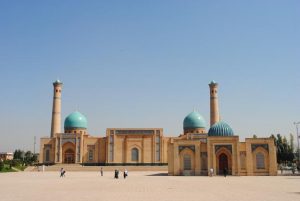Samarqand, city in east-central Uzbekistan that is one of the oldest cities of Central Asia and the second largest city in Uzbekistan after Tashkent . For thousand’s of years Samarkand prospered being located on one of the major trade routes to China. This famous city has got so many nick-names that they can really describe people’s attitude to it: the Mirror of the World, the Jewel of Islam, the Garden of Soul, the Center of the Universe…
In the 4th century BC Samarkand was known as Maracanda, it was the capital of Sogdiana and was captured (329) by Alexander the Great. The city was later ruled by Central Asian Turks (6th century AD), the Arabs (8th century), the Samanids of Iran (9th-10th century), and various Turkic peoples (11th-13th century) before it was annexed by the Khwarezm-Shah dynasty (early 13th century) and destroyed by the Mongol conqueror Genghis Khan (1220). After it revolted against its Mongol rulers (1365), Samarkand became the capital of the empire of Timur (Tamerlane), who made the city the most important economic and cultural centre in Central Asia. Samarkand was conquered by Uzbeks in 1500 and became part of the khanate of Bukhara. By the 18th century it had declined, and from the 1720s to the 1770s it was uninhabited. Only after it became a provincial capital of the Russian Empire (1887) and a railroad centre did it recover economically. It was for a short of time (1924-36) the capital of the Uzbek Soviet Socialist Republic.
Samarkand consists of an old city dating from medieval times and a new section built after the Russian conquest of the area in the 19th century. The old city’s plan consisted of streets converging toward the centre from six gates in the 5-mile- (8-kilometre-) long, 11th-century walls. The old city contains some of the finest monuments of Central Asian architecture from the 14th to the 20th century, including several buildings dating from the time when Samarkand was Timur’s capital city
Samarkand derived its commercial importance in ancient and medieval times from its location at the junction of trade routes from China and India. Samarkand city was once a large commercial center on the Great Silk Road.
As one the ancient poets said:” You can travel through the whole world, have a look at the pyramids and admire the smile of the Sphinx; You can listen to the soft singing of the wind at the Adriatic Sea and kneel down reverently at the ruins of the Acropolis, be dazzled by Rome with its Forum and Coliseum, be charmed by Notre Dame in Paris or by old domes of Milan; But if you have seen buildings of Samarkanda, you will be enchanted by its magic forever.”

